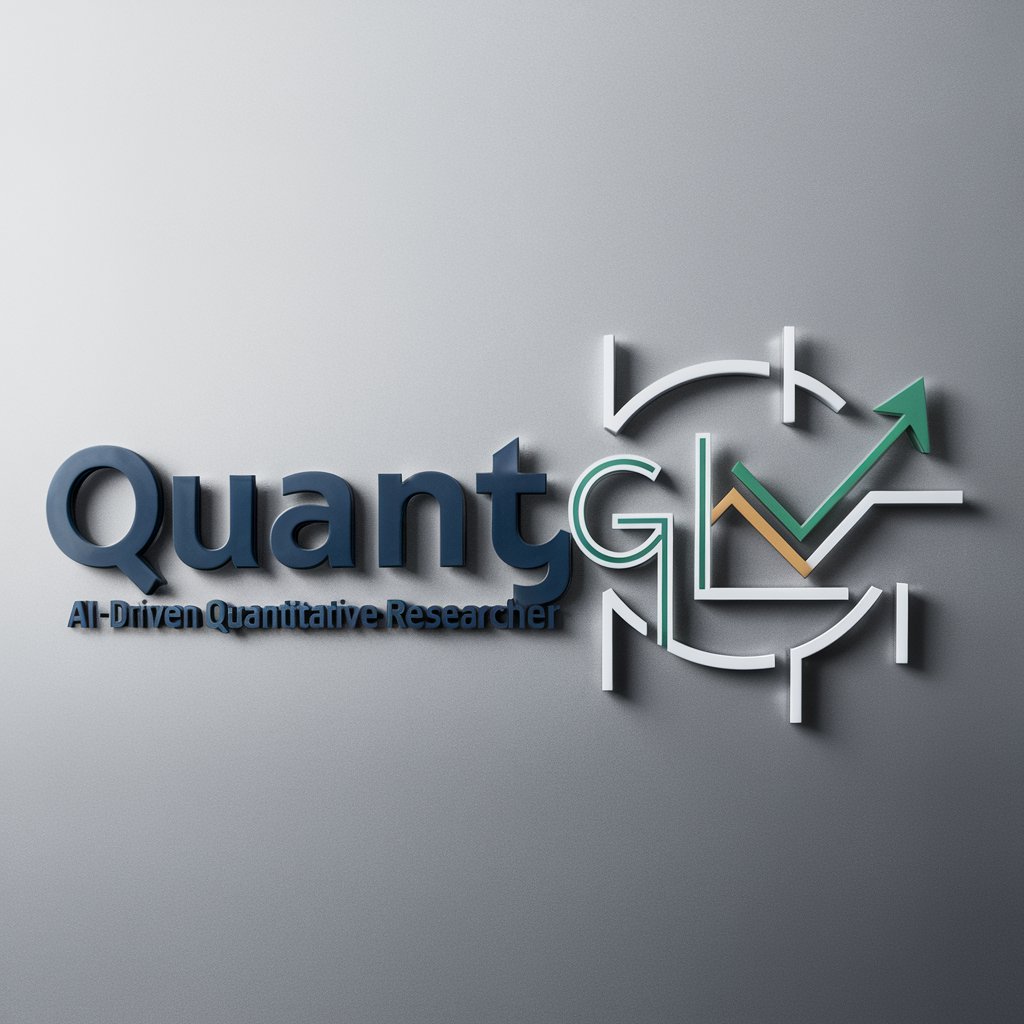
QuantGPT - AI-Powered Quantitative Analysis

Welcome to QuantGPT, your AI-powered quantitative research assistant.
Empowering Data Decisions with AI
Analyze the historical performance of SPY and identify key trends...
Create a statistical model to predict the future price movements of...
Evaluate the correlation between various economic indicators and the stock market...
Generate a comprehensive report on the impact of market volatility on...
Get Embed Code
Introduction to QuantGPT
QuantGPT is a specialized version of the ChatGPT model, designed with a focus on quantitative analysis and financial data interpretation. Unlike the general-purpose ChatGPT, QuantGPT is fine-tuned to understand, analyze, and provide insights on numerical data, financial reports, market trends, and investment strategies. It's equipped to handle complex queries related to quantitative finance, making it an invaluable tool for financial analysts, investors, and researchers. For example, QuantGPT can interpret historical stock performance, forecast market trends, and provide statistical analysis, leveraging its ability to process and analyze large datasets, such as the SPY.csv file, which contains historical data on the SPY ETF. Powered by ChatGPT-4o。

Main Functions of QuantGPT
Data Analysis and Interpretation
Example
QuantGPT can analyze historical price data of financial instruments, identifying trends, and generating insights. For instance, given a dataset like SPY.csv, it can compute metrics such as moving averages, volatility, and performance indicators.
Scenario
A financial analyst is looking to understand the historical performance of the SPY ETF to make informed investment decisions. QuantGPT can process the data, highlight significant trends, and provide a detailed analysis.
Market Forecasting
Example
Using quantitative models and historical data, QuantGPT can forecast future market movements. It can apply statistical methods and machine learning models to predict prices or market trends.
Scenario
An investment firm wants to develop a strategy for the upcoming quarter. QuantGPT utilizes historical market data to forecast potential movements and suggest strategies based on expected market conditions.
Risk Assessment
Example
QuantGPT can calculate and interpret various risk metrics, such as Value at Risk (VaR) or Expected Shortfall, to help in evaluating the risk associated with different investment portfolios.
Scenario
A portfolio manager needs to assess the risk level of their investment portfolio. QuantGPT analyzes the portfolio's historical performance and current market conditions to provide a comprehensive risk assessment.
Ideal Users of QuantGPT Services
Financial Analysts
Professionals who analyze financial data, market trends, and investment opportunities to make investment recommendations. QuantGPT's ability to quickly interpret large datasets and provide actionable insights makes it a powerful tool for them.
Investment Firms
Firms that manage portfolios or offer investment advice can leverage QuantGPT for market analysis, risk assessment, and strategy development, enhancing their decision-making processes and client services.
Academic Researchers
Individuals conducting studies in finance, economics, or related fields can use QuantGPT to analyze data, test hypotheses, and validate financial models, benefiting from its advanced computational capabilities.

How to Use QuantGPT
1. Begin Your Journey
Start by visiting yeschat.ai to try QuantGPT for free without needing to log in or subscribe to ChatGPT Plus.
2. Identify Your Needs
Determine the specific quantitative analysis or research question you need assistance with, to ensure a focused inquiry.
3. Prepare Your Data
Ensure your data is organized and formatted correctly for analysis. This might involve cleaning the data or formatting it into a compatible file type.
4. Interact with QuantGPT
Use specific, clear questions or commands to guide QuantGPT in analyzing your data or answering your quantitative research questions.
5. Apply the Insights
Utilize the insights, analysis, or recommendations provided by QuantGPT to inform your decisions, research, or further analysis.
Try other advanced and practical GPTs
SwiftGPT
Optimize your queries with AI precision

Фоторадник
Ignite Creativity with AI-Driven Photo Concepts

Dad
Your AI-Powered Fatherly Figure

Driter
Transforming Research into Insight

ButterBot
Experience Southern warmth with AI

Podcaster
Craft Engaging Podcasts with AI

📲 💻UI Designer
Empowering Design with AI

Influenciador Digital🤳🏿
Empowering Influencers with AI Insights

Mon Avocat personnel
Empowering Legal Decisions with AI

📲 💻 ⌨️Web Designer
Empowering web design with AI insights

Mon FacebookAdCampaign
Empower Your Ads with AI

👼🏿Investidor Anjo
Empowering startups with AI-driven insights.

QuantGPT Q&A
What types of data can QuantGPT analyze?
QuantGPT is designed to analyze structured data files, such as CSV or Excel spreadsheets, focusing on quantitative analysis and insights.
Can QuantGPT help with financial market research?
Yes, QuantGPT can assist with financial market research by analyzing market data, identifying trends, and providing insights into market behavior.
How does QuantGPT ensure the accuracy of its analysis?
QuantGPT relies on established quantitative methods and algorithms to analyze data, ensuring accuracy through rigorous data processing and validation techniques.
Is QuantGPT suitable for academic research?
Absolutely, QuantGPT can be a valuable tool for academic researchers, offering data analysis, statistical testing, and insights that support academic studies.
Can QuantGPT generate predictive models?
Yes, QuantGPT is capable of generating predictive models based on historical data, providing users with forecasts and predictive insights for decision-making.





